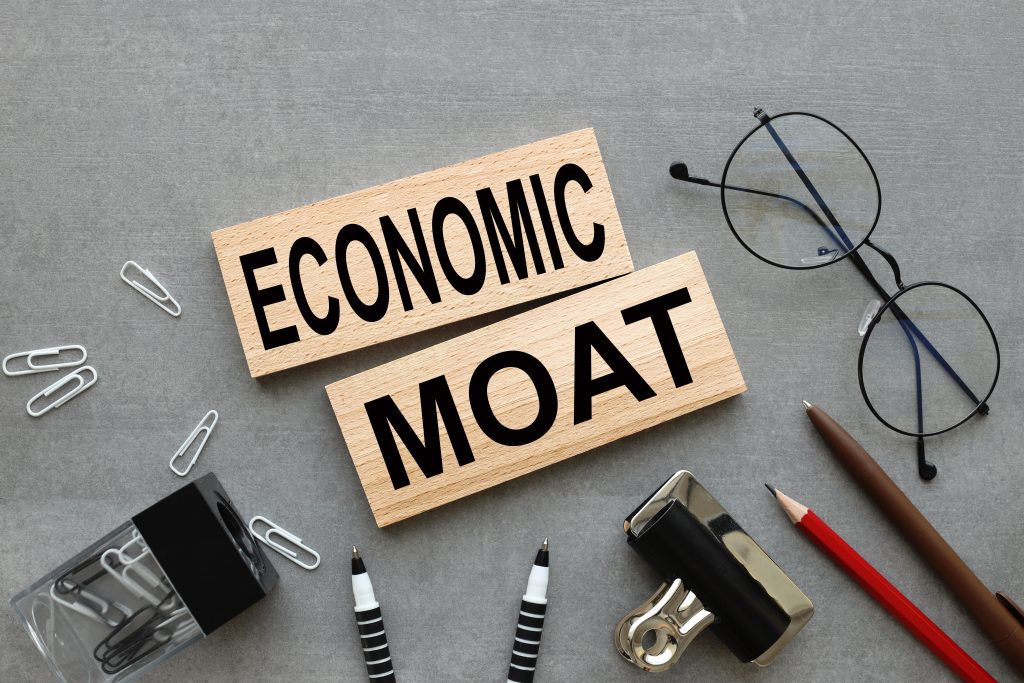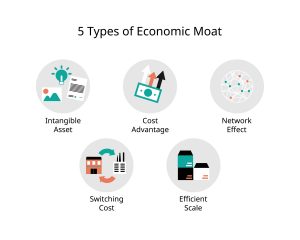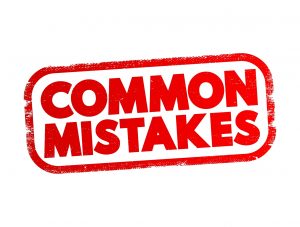
- Logo
- Ticker
- Company Name
- Exchange
- Previous close
Understanding Economic Moats: Identifying Companies with Long-Term Advantages

What is an Economic Moat?
An economic moat is a term used to describe a company’s ability to maintain a competitive advantage over its rivals, ensuring long-term profitability and sustainability. Just like a moat around a castle protects it from invaders, an economic moat shields a company from competitors. Companies with a strong economic moat can weather market challenges and continue to thrive over time.
The term was popularized by Warren Buffett, who uses it as a key principle in evaluating companies for their ability to sustain long-term stability and growth. Understanding how to recognize a company’s moat is essential for anyone looking to assess its long-term viability in the market.
Why Do Economic Moats Matter?
Economic moats are important because they provide companies with a sustainable edge over their competitors. A company with a strong moat can maintain market dominance and profitability even when faced with external threats such as new entrants, changing consumer preferences, or economic downturns.
Here are some reasons why economic moats are crucial for long-term success:
- Competitive Protection: A strong moat makes it harder for competitors to copy or overtake a company’s business model, allowing it to stay ahead in the market.
- Market Consistency: Companies with economic moats tend to have more stable earnings, as they are less affected by short-term market fluctuations.
- Long-Term Growth: Moats help companies create and maintain value over the long haul, making them more resilient to market challenges.
By identifying a company’s economic moat, you can better understand its future growth potential and ability to sustain profits over time.
Types of Economic Moats

Economic moats come in various forms, each offering a distinct competitive advantage. Here are the most common types of economic moats to look out for:
- Cost Advantages
Companies with a cost advantage can produce goods or services more efficiently than competitors. This advantage allows them to maintain profitability even in competitive markets.
Example: Walmart benefits from its supply chain efficiencies, allowing it to offer lower prices than many competitors.
- Network Effects
When the value of a product or service increases as more people use it, it creates a network effect. This is especially common in tech platforms.
Example: Facebook and Twitter (now X) benefit from network effects—more users increase the value of their platforms, making it difficult for new competitors to disrupt their market position.
- Intangible Assets
This type of moat includes brand recognition, patents, trademarks, and intellectual property. Strong brand identity and customer loyalty make it challenging for competitors to win market share.
Example: Apple has a strong brand that fosters customer loyalty, making it difficult for competitors to offer the same appeal.
- Switching Costs
Companies with high switching costs make it difficult for customers to change to a competitor. This creates long-term customer retention and stable revenue streams.
Example: Microsoft benefits from its software products that are deeply integrated into businesses, making it hard for customers to switch to other platforms.
- Efficient Scale
When a company dominates a particular market or region, its scale allows it to operate at lower costs than smaller competitors, creating a barrier to entry for others.
Example: Visa has an efficient global payment network, making it difficult for competitors to enter the market without significant infrastructure.
How to Identify a Company’s Economic Moat
Recognizing a company’s economic moat requires careful analysis of both quantitative and qualitative factors. Here are some steps to help identify companies with economic moats:
- Evaluate Market Position: Look for companies that hold dominant positions in their industries and have a clear competitive advantage.
- Analyze Financials: Companies with strong, consistent profit margins and cash flow are often good candidates for having an economic moat.
- Assess Brand Power: Companies with a strong, well-recognized brand are likely to have a significant moat, especially if customers exhibit high loyalty.
- Examine Barriers to Entry: Consider the challenges new companies would face if they tried to enter the market. High startup costs, complex technology, or regulatory hurdles can create strong moats.
Focusing on these areas provides a clear path to evaluating whether a company has a sustainable competitive edge.
How Invetso Helps You Identify Economic Moats
At Invetso, we provide structured frameworks that simplify the process of evaluating a company’s competitive advantages. Using insights from our Economic Moat framework, you can analyze factors like cost efficiencies, market positioning, and barriers to entry in a streamlined and intuitive way.
With our AI-powered platform, you gain access to qualitative insights that help you assess whether a company has the potential to sustain its advantage over competitors. This approach saves you time while delivering a holistic view of the companies you’re researching.
Key Takeaways
- An economic moat protects a company from competitors, ensuring long-term profitability and market dominance.
- Common types of moats include cost advantages, network effects, intangible assets, switching costs, and efficient scale.
- Identifying a company’s moat involves evaluating its market position, financials, brand strength, and barriers to entry.
- Invetso makes it easier to assess economic moats with AI-powered frameworks that offer deep, qualitative insights into companies’ competitive advantages.
Ready to elevate your analysis?
Sign up for Invetso today and start exploring the competitive advantages that can help you make more informed decisions. Unlock qualitative insights and uncover the true potential of companies with our advanced frameworks.
Disclaimer: Invetso is not a financial advisor. All information provided is for educational and informational purposes only. Always conduct your own research before making any decisions.
You can continue reading
Understanding Economic Moats: Identifying Companies with Long-Term Advantages

What is an Economic Moat?
An economic moat is a term used to describe a company’s ability to maintain a competitive advantage over its rivals, ensuring long-term profitability and sustainability. Just like a moat around a castle protects it from invaders, an economic moat shields a company from competitors. Companies with a strong economic moat can weather market challenges and continue to thrive over time.
The term was popularized by Warren Buffett, who uses it as a key principle in evaluating companies for their ability to sustain long-term stability and growth. Understanding how to recognize a company’s moat is essential for anyone looking to assess its long-term viability in the market.
Why Do Economic Moats Matter?
Economic moats are important because they provide companies with a sustainable edge over their competitors. A company with a strong moat can maintain market dominance and profitability even when faced with external threats such as new entrants, changing consumer preferences, or economic downturns.
Here are some reasons why economic moats are crucial for long-term success:
- Competitive Protection: A strong moat makes it harder for competitors to copy or overtake a company’s business model, allowing it to stay ahead in the market.
- Market Consistency: Companies with economic moats tend to have more stable earnings, as they are less affected by short-term market fluctuations.
- Long-Term Growth: Moats help companies create and maintain value over the long haul, making them more resilient to market challenges.
By identifying a company’s economic moat, you can better understand its future growth potential and ability to sustain profits over time.
Types of Economic Moats

Economic moats come in various forms, each offering a distinct competitive advantage. Here are the most common types of economic moats to look out for:
- Cost Advantages
Companies with a cost advantage can produce goods or services more efficiently than competitors. This advantage allows them to maintain profitability even in competitive markets.
Example: Walmart benefits from its supply chain efficiencies, allowing it to offer lower prices than many competitors.
- Network Effects
When the value of a product or service increases as more people use it, it creates a network effect. This is especially common in tech platforms.
Example: Facebook and Twitter (now X) benefit from network effects—more users increase the value of their platforms, making it difficult for new competitors to disrupt their market position.
- Intangible Assets
This type of moat includes brand recognition, patents, trademarks, and intellectual property. Strong brand identity and customer loyalty make it challenging for competitors to win market share.
Example: Apple has a strong brand that fosters customer loyalty, making it difficult for competitors to offer the same appeal.
- Switching Costs
Companies with high switching costs make it difficult for customers to change to a competitor. This creates long-term customer retention and stable revenue streams.
Example: Microsoft benefits from its software products that are deeply integrated into businesses, making it hard for customers to switch to other platforms.
- Efficient Scale
When a company dominates a particular market or region, its scale allows it to operate at lower costs than smaller competitors, creating a barrier to entry for others.
Example: Visa has an efficient global payment network, making it difficult for competitors to enter the market without significant infrastructure.
How to Identify a Company’s Economic Moat
Recognizing a company’s economic moat requires careful analysis of both quantitative and qualitative factors. Here are some steps to help identify companies with economic moats:
- Evaluate Market Position: Look for companies that hold dominant positions in their industries and have a clear competitive advantage.
- Analyze Financials: Companies with strong, consistent profit margins and cash flow are often good candidates for having an economic moat.
- Assess Brand Power: Companies with a strong, well-recognized brand are likely to have a significant moat, especially if customers exhibit high loyalty.
- Examine Barriers to Entry: Consider the challenges new companies would face if they tried to enter the market. High startup costs, complex technology, or regulatory hurdles can create strong moats.
Focusing on these areas provides a clear path to evaluating whether a company has a sustainable competitive edge.
How Invetso Helps You Identify Economic Moats
At Invetso, we provide structured frameworks that simplify the process of evaluating a company’s competitive advantages. Using insights from our Economic Moat framework, you can analyze factors like cost efficiencies, market positioning, and barriers to entry in a streamlined and intuitive way.
With our AI-powered platform, you gain access to qualitative insights that help you assess whether a company has the potential to sustain its advantage over competitors. This approach saves you time while delivering a holistic view of the companies you’re researching.
Key Takeaways
- An economic moat protects a company from competitors, ensuring long-term profitability and market dominance.
- Common types of moats include cost advantages, network effects, intangible assets, switching costs, and efficient scale.
- Identifying a company’s moat involves evaluating its market position, financials, brand strength, and barriers to entry.
- Invetso makes it easier to assess economic moats with AI-powered frameworks that offer deep, qualitative insights into companies’ competitive advantages.
Ready to elevate your analysis?
Sign up for Invetso today and start exploring the competitive advantages that can help you make more informed decisions. Unlock qualitative insights and uncover the true potential of companies with our advanced frameworks.
Disclaimer: Invetso is not a financial advisor. All information provided is for educational and informational purposes only. Always conduct your own research before making any decisions.
You can continue reading
Unlock exclusive Perks
Be part of a select group and enjoy exclusive benefits reserved only for our Premium members.

- Logo
- Ticker
- Company Name
- Exchange
- Previous close
Updated: November 24, 2025
We have not found the stock you are looking for


